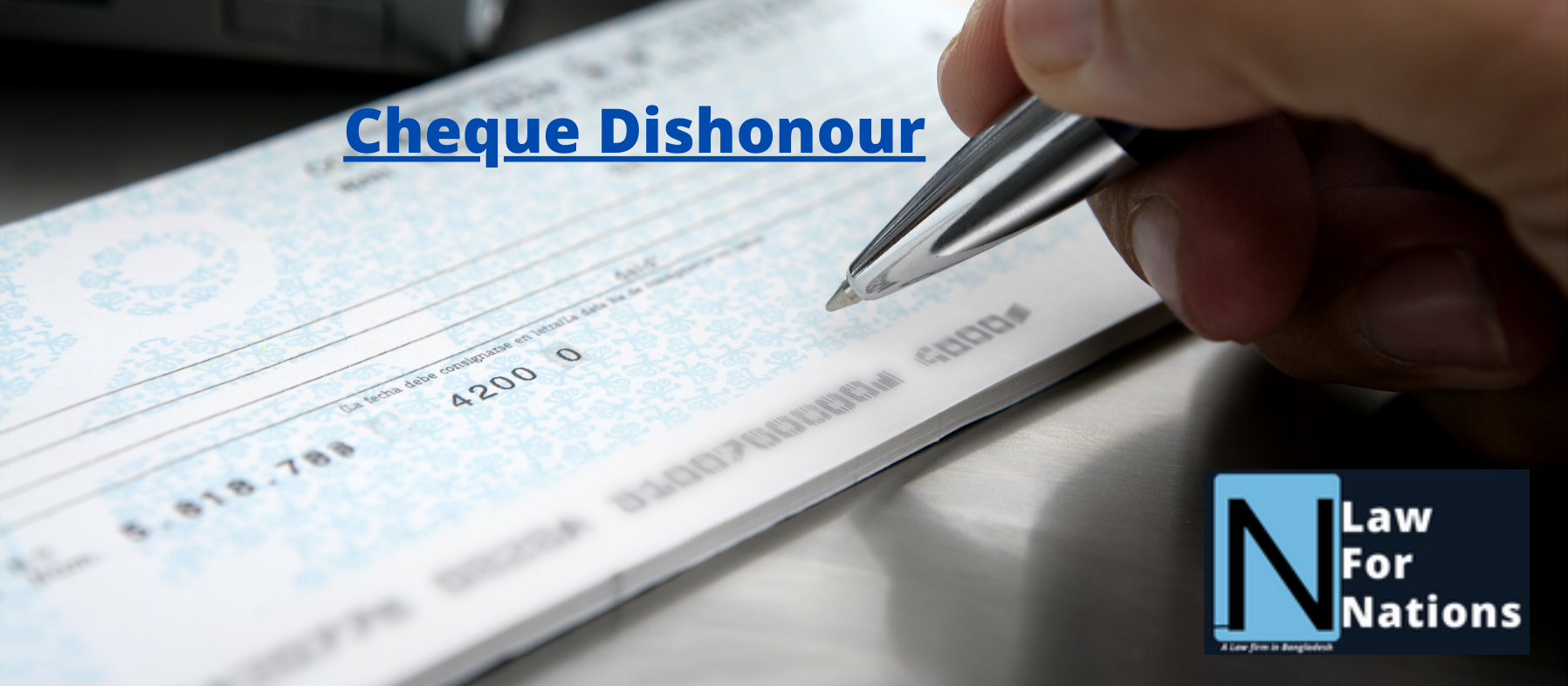
How to file a Cheque Dishonor case?
Now a day’s Cheque Dishonor is most common issue in our society. A Cheque dishonor case is filed under the The Negotiable Instruments Act, 1881. Furthermore This Act has been amended many times since 1881. Section 138 of this act deals with Cheque Dishonor issue. Sometimescheques bearing large amounts remain unpaid and are returned by the bank on which they are
drawn. Legally, the author of the cheque is called ‘drawer’, the person in whose favour the cheque is drawn is called ‘payee’ and the bank who is directed to pay the amount is known as ‘drawee’.
Nature of Offence: According to Section 138 of the Act, dishonour of cheque is a criminal offence.
Punishment: Imprisonment up to 2 (two) years or with monetary penalty or with both. If payee decides to proceed legally, then the drawer should be given a chance of repaying the cheque amount immediately. Such a chance has to be given only in the form of notice in writing. Legal Notice: The payee has to send the notice to the drawer within 30 days from the date of receiving “Cheque Return Memorendum” from the bank. The notice should mention that the
amount in cheque has to be paid to the payee within 30 days from the date of receipt of the notice
by the drawer. If the drawer fails to make a payment within 30 days of receiving the notice, the
payee has the right to file a criminal complaint under Section 138 of the Negotiable Instruments
Act.
However, the complaint should be registered in a magistrate’s court within one month of the
expiry of the notice period. It is essential in this case to consult an advocate who is well versed
and experienced in this area of practice to proceed further in that matter.
The payee may legally sue the defaulter / drawer for dishonour of cheque only if the amount
mentioned in the cheque is towards discharge of a debt or any other liability of the defaulter
towards payee.
N.B. If the cheque was issued as a gift, towards lending a loan or for unlawful purposes, then the
drawer cannot be prosecuted in such cases.
A cheque is a negotiable instrument. Crossed and account payee cheques are not negotiable by
any person other than the payee. The cheque have to be deposited into the payee's bank account.
Purpose:
The payee has the proper legal right to sue the drawer/ defaulter for cheque dishonour. Best
whilst the quantity stated in the cheque is in the direction of the release of any legal
responsibility or debt of defaulter in the direction of payee.
Areas of Application of Law:
According to section 138 dishonour of the cheque is a criminal offence and the punishment
involves imprisonment of 2 years or monetary penalty or may be both Or As indicated by the
segment 138 shame of the check is a lawbreaker matter and the discipline includes detainment of
2 years or financial punishment or might be both.
Process:
1. A legal notice on payee’s behalf is send to the defaulter, within 30 days of cheque dishonour.
All the facts including nature of the transaction, loan amount or any other enforceable debt
against which the cheque was issued and the date of deposit in the bank along with the date of
dishonour of the cheque should be clearly mentioned in that notice.
2. The cheque issuer is directed through notice to make the payment of the amount of cheque
dishonour within 30 days. If the accused made the payment within that period of time then the
matter automatically end out of court.
3. When the amount is not made within 30 days then the cheque holder should immediately file a
criminal case because the time period given to them is 30 days from expiry of that period of time
(30 Days). It is always suggested to hire an advocate experience in handling this matter in the court.
4. The complainant is supposed to file the case in the court where the concerned bank is situated.
Affidavit and relevant documents should be carried along with the complaint.
5. The respective court will definitely hear to the complainant or the advocate on his/her behalf
and summons the accused under section 138 of the NI Act.
6. The summons is served to the accused at his/her residence through the nearby police station.
Sometimes summons are also served through speed post by the authorized courier service and
when it is not accepted by the accused then it will be treated as “Duly Served”.
7. Police station is usually limited to only summons serving. In any case accused remains absent
before court after summons being served, and then warrant will be issued to the concerned police
station to present accused before the court.
8. The accused or the guarantee is supposed to appear in the court and submit all the necessary
documents like NID copy, Passport, address proof along with other documents, photo, and etc.).
9. If the court accepts the surety and once the bond is signed by both surety and accused the court
will grant bail to the accused.
10. The lawyer of the accused will cross examine all the witnesses along with the complainant’s
Statement against the accused which is recorded Under Section 313 of Cr.P.C. Where he
(accused) is supposed to answer the questions and the allegations brought against him.
12. The final stage is the arguments between the advocates of both the parties.
13. The court will give its judgment after hearing the final arguments.
14. If the accused is acquitted then the matter ends there or in case if he/she is convicted then he
would immediately submit a bail application and give surety and plead for time to appeal in the
sessions Court.
The court will direct the convict to deposit the fine mentioned during the judgment immediately
and only then he will be released subsequently on the acceptance of the bail application. The
convicted person should appeal to the session Judge court within one month from the date of the
judgment of the lower Court.
15. The Dispute may also go from Sessions Court to the higher Courts as well. However matter
can also be settled anytime between both the parties. In that case such settlement application
would be moved before the respective court to close the case.
Documents required for case:
1. Dishonoured Cheque
2.Vakalatnama of the advocate.
3.Proof of the dispatch of sent legal notice.
4.Bank memo stating the reason for cheque dishonour.
5.Postal acknowledgment by the accused.
6.Copy of the notice being sent to the accused.
7.Any document which is evidence of creation of the debt or the liability.
9.Any contract or agreement between the complainant and the accused including the orders
placed.
10.The bill or invoice against the dishonoured cheque was issued.
Punishment
If Court founds the person to be guilty then the fine which may double the amount of the
dishonoured cheque or imprisonment of at least two years or may be both and when the drawer
makes the payment within 30 days from the receipt date of the notice then the case gets dissolved
and it won’t be considered as offence anymore.
